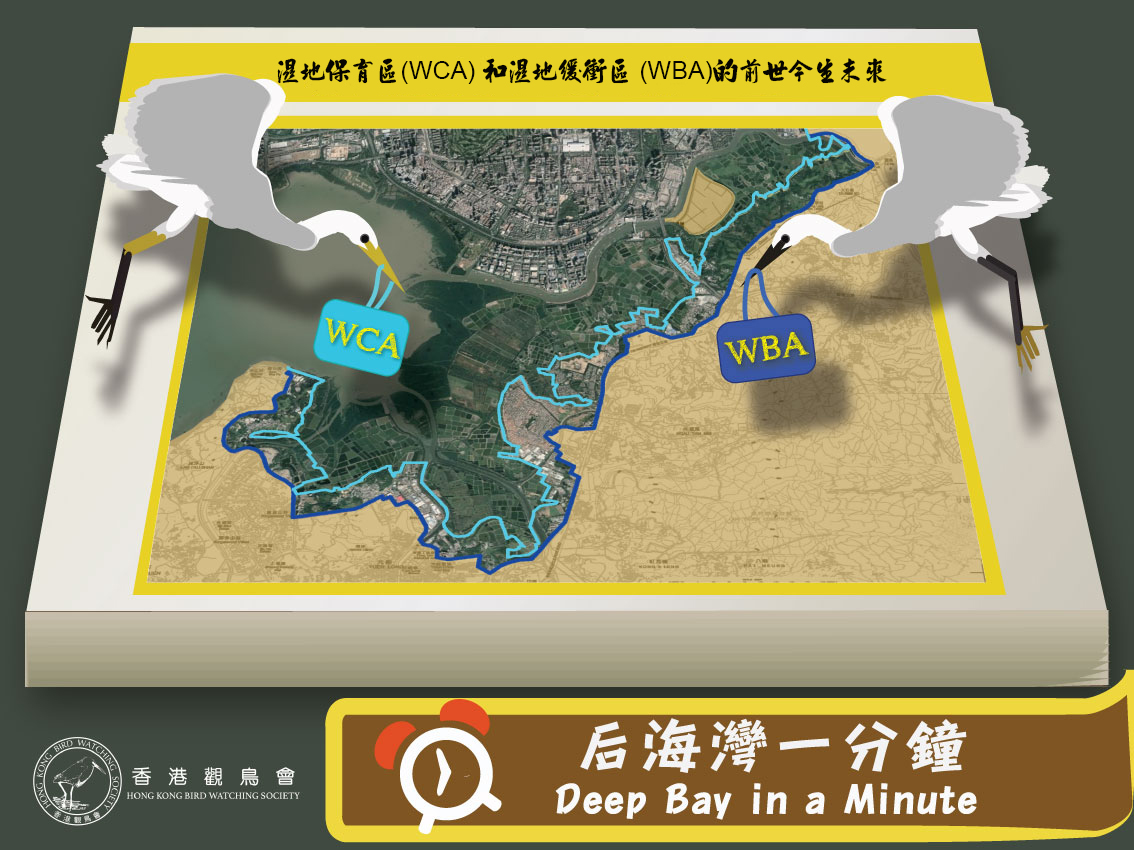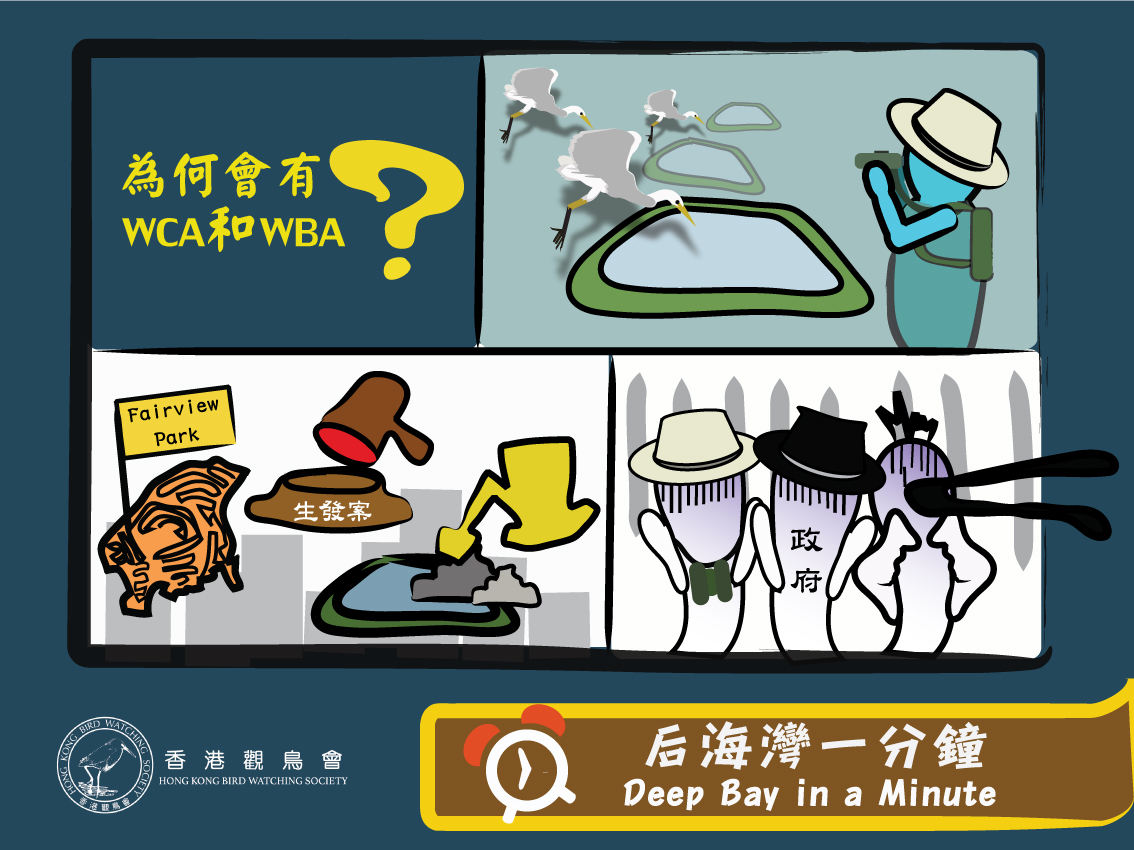【Deep Bay in a minute】
1. What is WCA and WBA?
2. Where did WCA and WBA come from?
3. Why birds love working fishponds?
4. Why bird was selected as an indicator of the ecological function of fishponds?
5. Any difference between the birds in Mai Po and in fishponds?
6. What happens in the abandoned fishponds?
7. Why fishponds are being abandoned?
8. Breeding egrets and herons in the Deep Bay area
9. Pond bunds: an ecological fabric or development tactic?
→Support HKBWS's bird conservation and research work NOW!
The Deep Bay wetlands and mudflats is a globally recognized foraging and roosting ground for waterbirds and other migrant winter birds. The Mai Po marshes were gradually protected under Hong Kong legislation and actively managed during the 1970s and 80s. Yet, it was not until the Study on the Ecological Value of Fishponds in the Deep Bay Area completed in 1997 that formally recognized the ecological value of fishponds. In fact, the fishponds are ecologically connected to the Mai Po Marshes and form an integral part of the Deep Bay wetland ecosystem. Therefore, the continuous and adjoining wetlands and fishponds in the Deep Bay, including such areas as San Tin, Nam Sang Wai, Lut Chau and Hoo Hook Wai should be conserved in order to maintain its ecological integrity.
As the development pressure increased, the Town Planning Board established the “Wetland Conservation Area” (WCA) and “Wetland Buffer Area” (WBA) to regulate applications for different land use and development in the Deep Bay Area. Under the Town Planning Board Guideline No 12 the WCA was designated to conserve the core area which consists of continuous and adjoining fishponds, while WBA was designated as a buffer zone to protect the WCA. No new development is allowed within the WCA unless it supports nature conservation in the area or is an essential infrastructure with overriding public interest. Residential or recreational development in the WBA, which helps to remove the existing open storage use and/or to restore some of the fishponds and would not have adverse ecological impacts on the WCA may be allowed.
Besides the WCA and WBA, the “precautionary approach”, which states that you should not take an action without being aware of the outcome, and the principle of “no-net-loss in wetland” are also important concepts adopted in Guideline 12.
HKBWS considers that the above planning controls and principles should be strictly followed in order to conserve the ecological integrity of the Deep Bay wetland ecosystem.
Where did WCA and WBA come from?
Since the 1960s, development pressure started to encroach into the Deep Bay area, with new developments such as Fairview Park and Tin Shui Wai New Town emerging in the 1980s and 1990s. The “Melhado” case in 1983, in which the High Court ruled that land zoned for agriculture may be used for non-agricultural purposes as long as no structure is built, has led to the draining of fishponds for brownfield operations such as container storage that threatened the wetlands in the Deep Bay area.
In 1988, the Environmental Protection Department commissioned a consultant to study the impacts of development activities on the environmental and natural resources of Deep Bay and to develop an action plan for the management of the Deep Bay. The study recognized the importance of the Deep Bay wetlands and recommended conservation actions including the establishment of integrated conservation management plans and buffer zones for Deep Bay.
In 1991, development control in rural areas was introduced under the Town Planning Ordinance (TPO). In 1992, the Planning Department established a set of planning guidelines under the TPO to regulate development applications in the Deep Bay area with Buffer Zones 1 (BZ1) and 2 (BZ2).
In 1995 Mai Po and Inner Deep Bay was recognized as wetland of International Importance under the Ramsar Convention. In the same year the Planning Department commissioned a study on the Ecological Value of Fish Ponds in the Deep Bay Area, which confirmed the ecological importance of fishponds. The study recommended that the continuous and adjoining fishponds should be conserved and to be zoned as “Wetland Conservation Area” (WCA), while a surrounding buffer zone of about 500m wide to be designated as “Wetland Buffer Area” (WBA). In 1999, the BZ1 and BZ2 were replaced by WCA and WBA and was extended to cover the Hoo Hok Wai and Ma Tso Lung area in 2014 after the opening of the frontier closed area.
In 2004, the Inner Deep Bay and Shenzhen River catchment area, including areas of WCA/WBA and other areas stretching from Pak Nai and Lau Fau Shan to Long Valley, was recognized by Birdlife International an Important Bird Area.
Why birds love working fishponds?
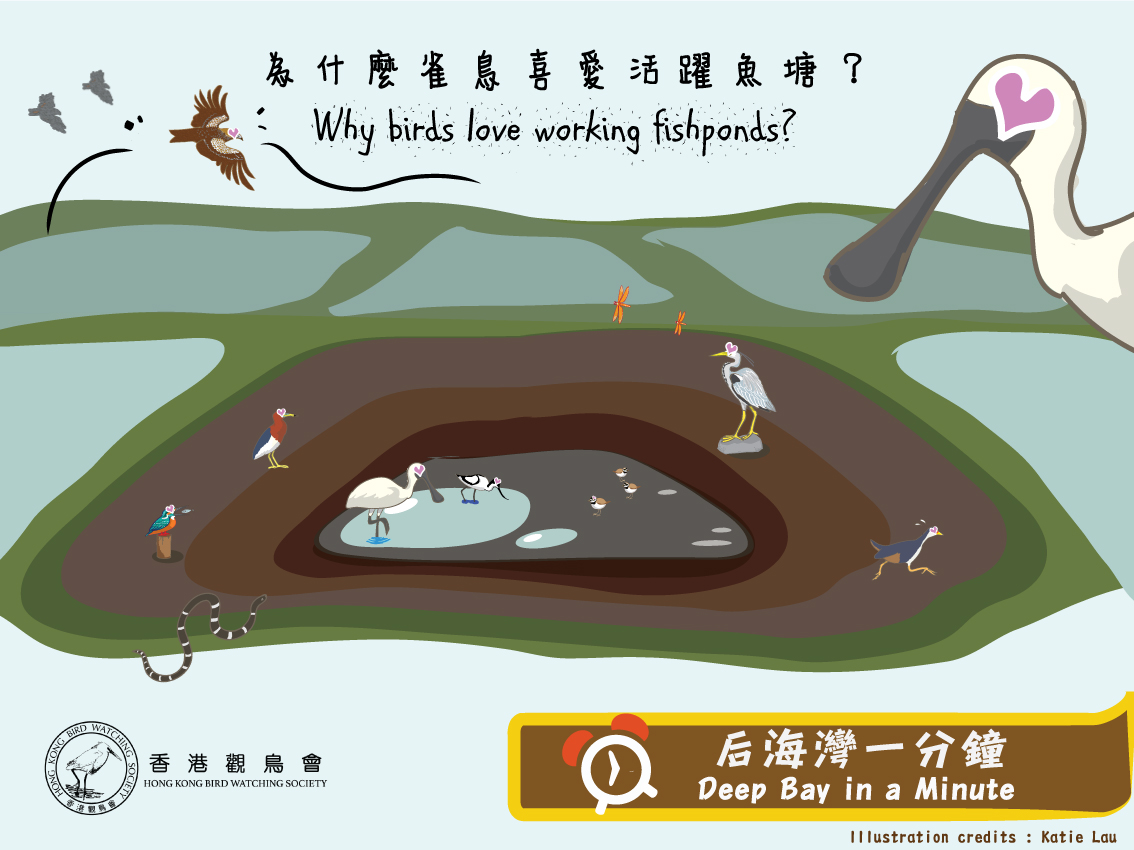
Interestingly, the ecological value of fishponds is related to its operation. When fishermen drain the ponds to harvest their fish, the trash fish (those that are too small to be sold) and other invertebrates left in the shallow water of the pond creates a favourable feeding habitat for waterbirds. 83 waterbirds and other wetland-dependent bird species were recorded utilizing drained fishponds, including 11 globally threatened species. These include the critically endangered Spoon-billed Sandpiper and the endangered Black-faced Spoonbill. The number of waterbird species recorded during drain-down was found to be about 19 times higher than the number recorded before the fishpond drain-down.
In 2012 HKBWS established a Management Agreement with a number of fishpond operators in Deep Bay with funding support from the Environment and Conservation Fund, under which each fishpond must be drained for at least a week per year. This is an example of “wise use of wetland”, where conservation of wetland is achieved through the engagement of the local fishpond operators, as it is both economically and socially sustainable, as well as beneficial for the environment. Every year, fishpond operators participated in the scheme are managing over 600 hectares of fishponds in the Deep Bay area.
However, as the drain down is market driven, the number of drained fishponds at any one time only represent a small percentage of the total, and thus the food supply for birds at fishponds changes over both time and space. Therefore, it is important to conserve a large number of fishponds, so as to ensure there are drained fishponds at any given time in order to maintain the food supply for birds.
Why bird was selected as an indicator of the ecological function of fishponds?
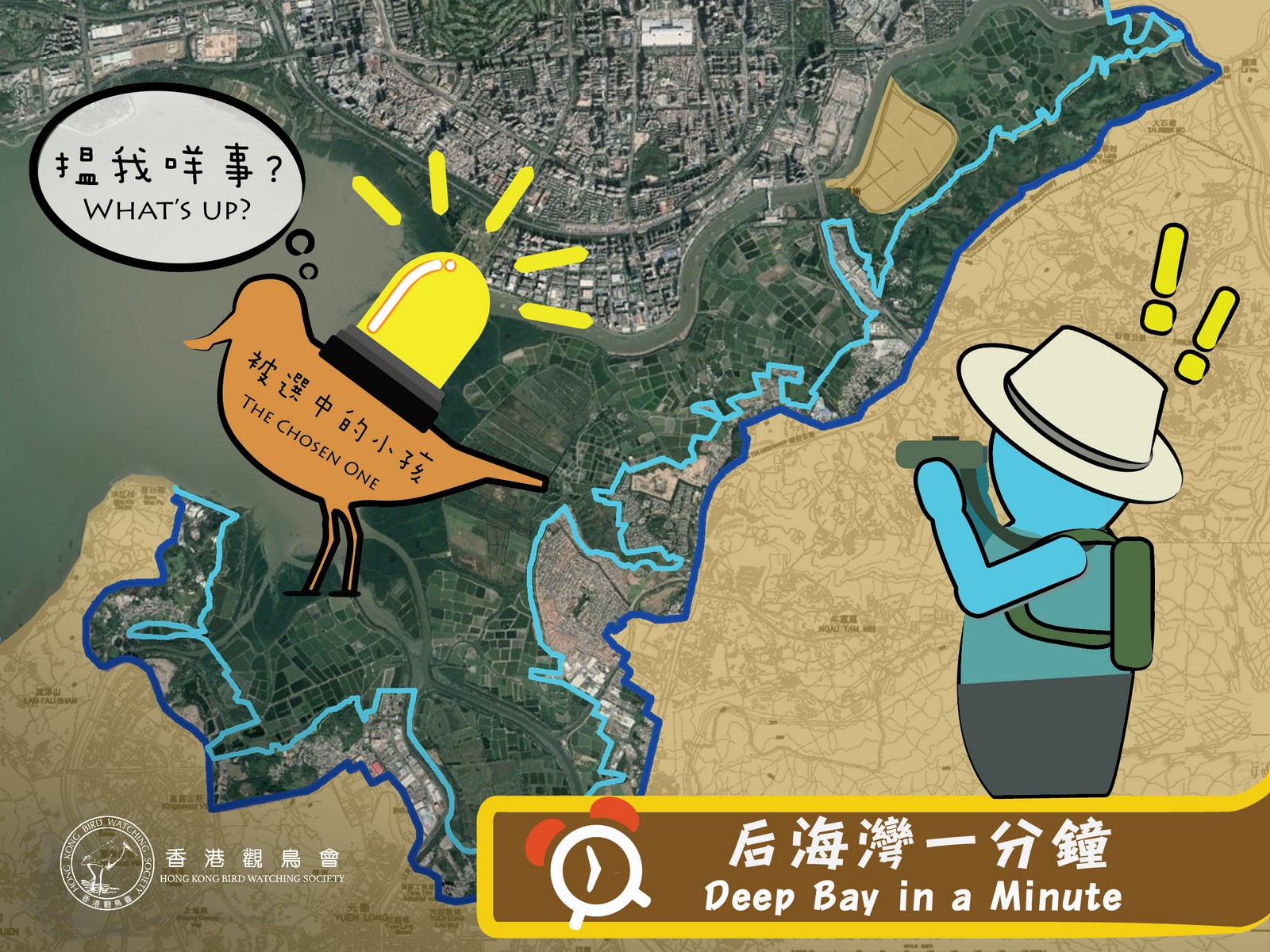
In the “Study on the Ecological Value of Fishponds in the Deep Bay Area” (1997) commissioned by the Planning Department, bird was selected as the key indicator of the ecological function of fishponds, because:
- Birds are at the highest levels in the food web, and presume birds in general require more territorial space, thus they can represent the health status of the environment.
- Birds are present all year round and can be observed directly.
- Birds are taxonomically well known and can be identify at a distance without disturbance.
- Birds are better documented than other wildlife locally, regionally and globally.
- Birds are one of the key conservation targets in the Deep Bay area.
In addition, there is a long dataset of bird records in the Deep Bay area for analysis. HKBWS started monitoring of waterbirds in the area since 1979. It was expanded to monthly waterbird count with funding support from the Agriculture, Fisheries and Conservation Department since 1997. Long term monitoring provides important information on the population and trends of waterbirds in the Deep Bay wetlands.
Any difference between the birds in Mai Po and in fishponds?
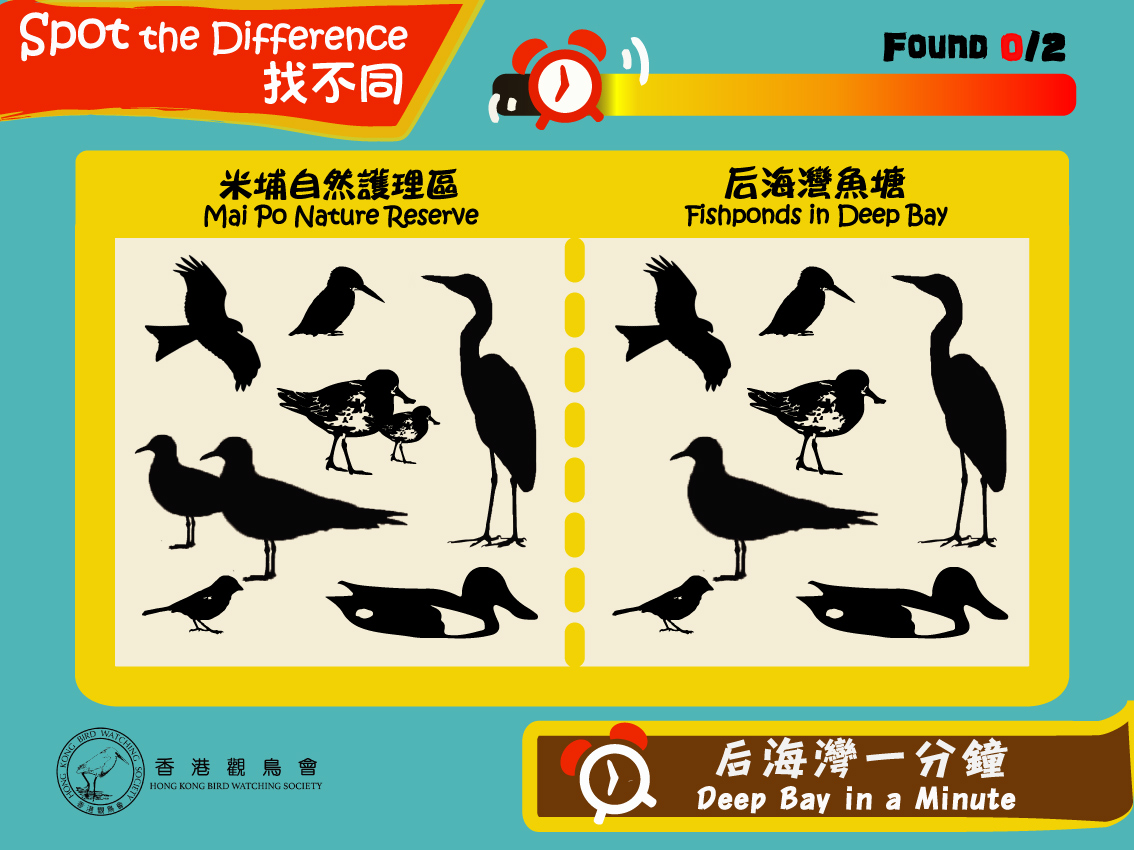
In the 1997 fishpond study, bird species recorded in Mai Po Nature Reserve (MPNR) and in three fishpond areas (i.e. Ma Tso Lung, Lin Barn Tsuen and Lut Chau/Nam Sang Wai) were compared. A total of 223 and 168 bird species were recorded in a year in MPNR and the fishpond area respectively. Mai Po had significantly more waders, gulls and terns, perhaps it is closer to the mudflat and has suitable roosting habitats. Yet, other bird groups were similar. Most of the threatened species recorded in the Deep Bay area, such as the globally endangered Black-faced Spoonbill, were also recorded in the fishpond area. When comparing the peak bird counts of waterbirds in Deep Bay, MPNR and fishponds, much the same patterns were observed. This similarity in bird composition and bird abundance pattern suggests that MPNR and the fishpond area across the Deep Bay should be treated as one integral system.
Our recent satellite tracking research conducted in 2018 found that the activity range of one Little Egret within a year can covered the inner Deep Bay, including in the mudflats, MPNR and fishpond area. It even bred in one of the egretries in Deep Bay during summer. This further confirms that birds do not distinguish the boundary at MPNR, but identifies the suitable habitats within the whole Deep Bay area. Therefore, the fishponds and MPNR should be treated collectively as part of the same ecosystem.
What happens in the abandoned fishponds?
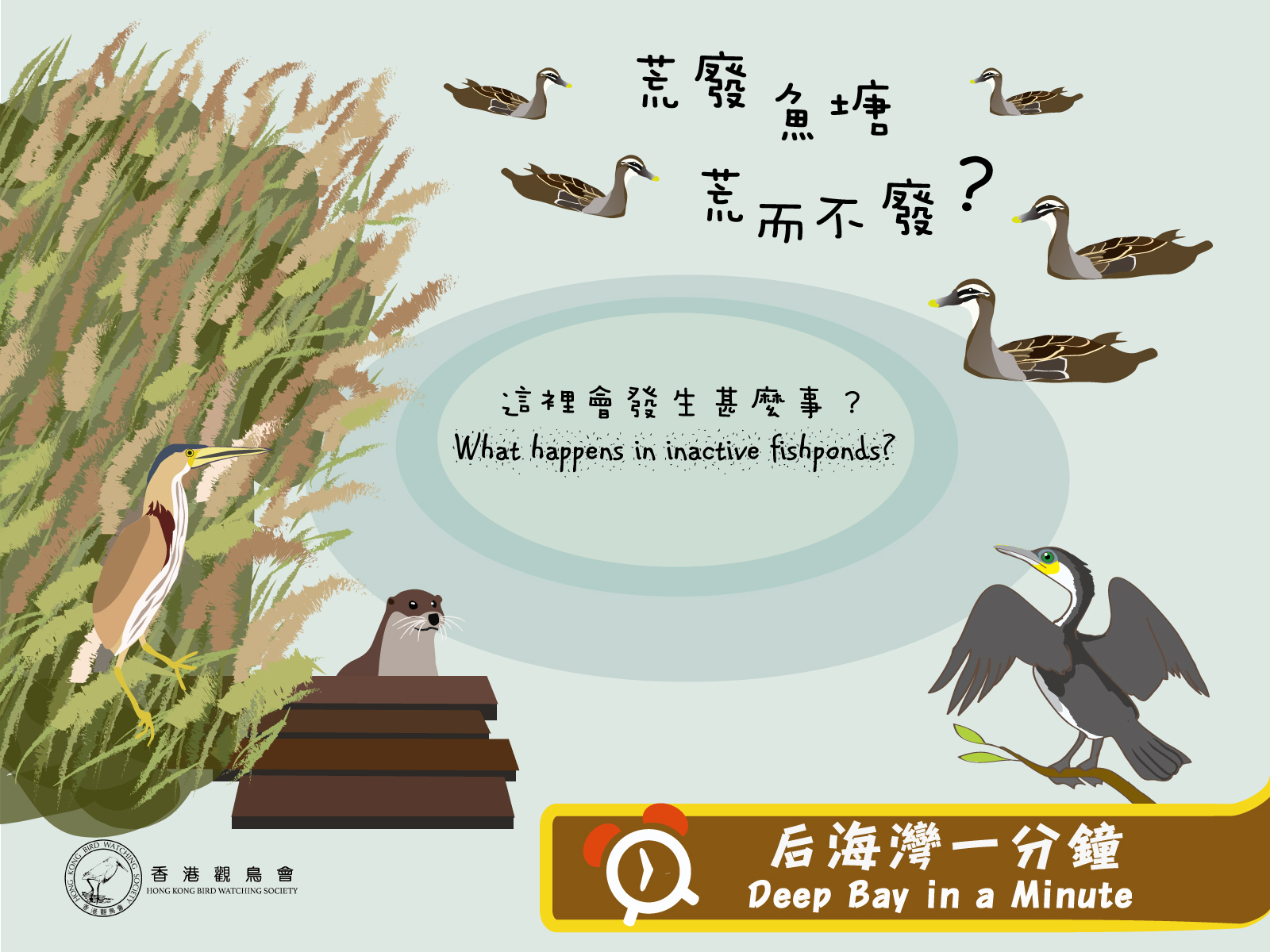
Abandoned fishponds generally mean fishponds without active human management. There will not be any drain-down regime at the fishponds but instead will become rain fed. The lack of fishpond bund maintenance may cause the fishpond to become subject to tidal influence. There will be no control over bund and emergent vegetation in the fishpond. Some people may think abandoned fishponds are of lower ecological value. Yet, habitats of abandoned fishponds vary a lot and depend on factors including the time of abandonment and the surrounding ecological environment.
The Government’s 1997 Fishpond Study recorded overall higher percentage of reed and emergent vegetation coverage in abandoned fishponds than in operating ones. It also recorded more species of ducks use abandoned fishponds during the winter. Even though some of the fishponds in Nam Sang Wai were inactive for decades and were gradually overgrown with reeds, a consultancy assessment in 2011 commented that it is one of the largest area of reed habitat in Hong Kong. The reedbed provide suitable foraging and roosting habitat for various wildlife of conservation concern, including Yellow Bittern of local concern, Chinese Penduline Tit of regional concern, and the globally near threatened Eurasian Otter. Therefore, abandoned fishponds have different habitat characteristics from operating ones and their ecological functions should not be overlooked.
Why fishponds are being abandoned?
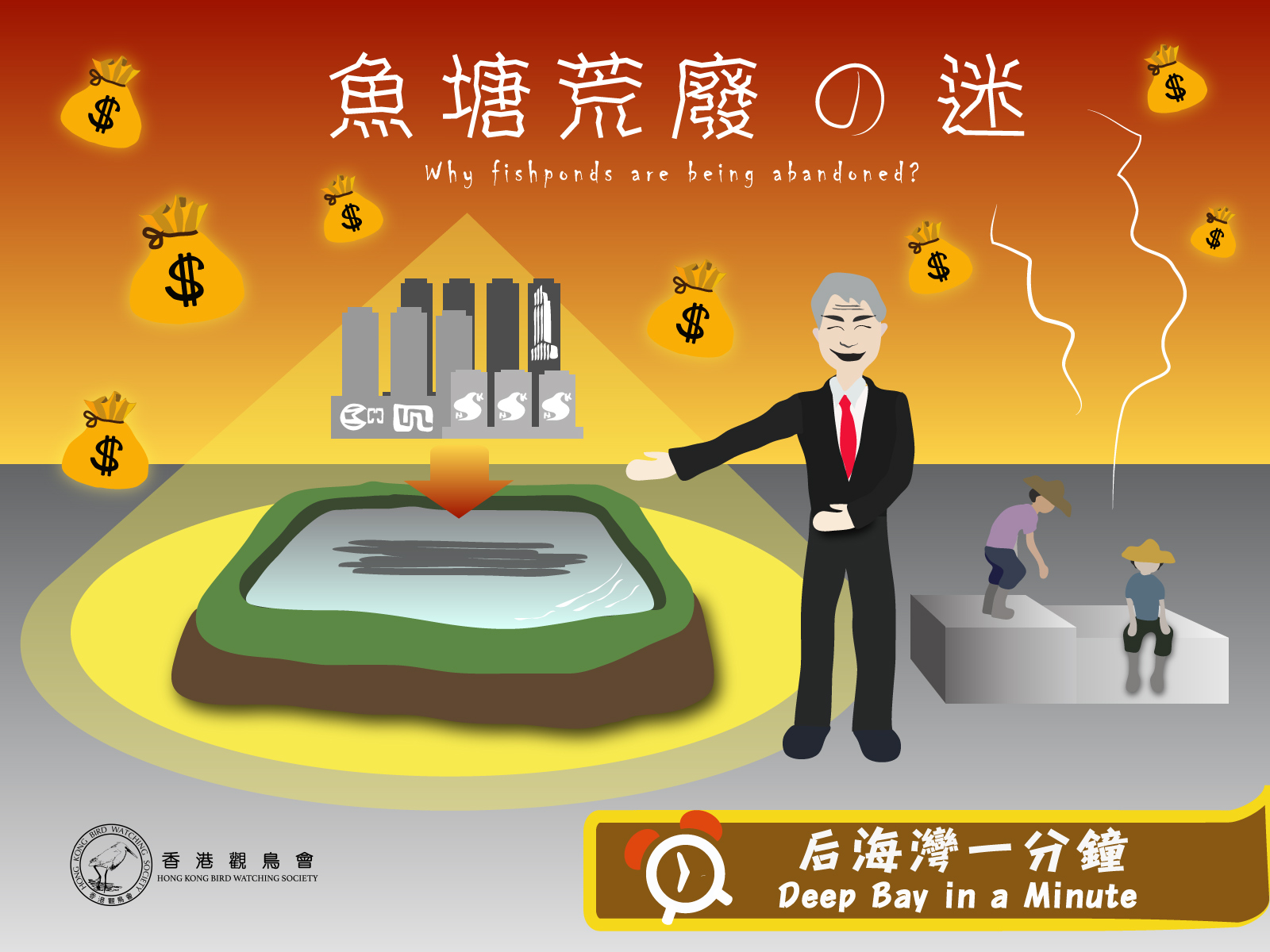
Many fishponds were left inactive due to land speculation by landowners and developers in hope of securing property development right with a much higher return than pond fish culture. Fishponds in Nam Sang Wai were abandoned in early 90s, and since then the land owner and developer continuously sought development permission, yet their recent high-rise residential development proposal was rejected by the Town Planning Board. Fishpond farmers have been managing and operating the fishponds in Fung Lok Wai and even participated the Society’s Fishpond Management Agreement (MA) Scheme to fulfil some operation requirements for bird conservation. Yet, as development permission was granted by the Town Planning Board in 2013, the developer forced the fishpond farmers to leave and the fishponds have been abandoned since 2016.
When talking about the management of wetlands, the discussion should not be limited to how property development can support the conservation of wetlands. Developers and land owners should properly manage their land and tenants to ensure waste are not dumped on their lands. Nature Conservation Management Agreement projects can be applied through funds from the Government for the management of reedbeds and wetlands other than fishponds. As pond fish culture itself is a “wise use of wetland” and a part of our agriculture culture, the Government should reactivate and operate abandoned fishponds on Government land, or actively manage the wetlands for wildlife. Given the ecological value of fishponds is strongly related to fishpond operation, the Government should also boost the economic support to local pond fish culture for sustainable conservation of birds and wetlands in the Deep Bay area.
Breeding egrets and herons in the Deep Bay area
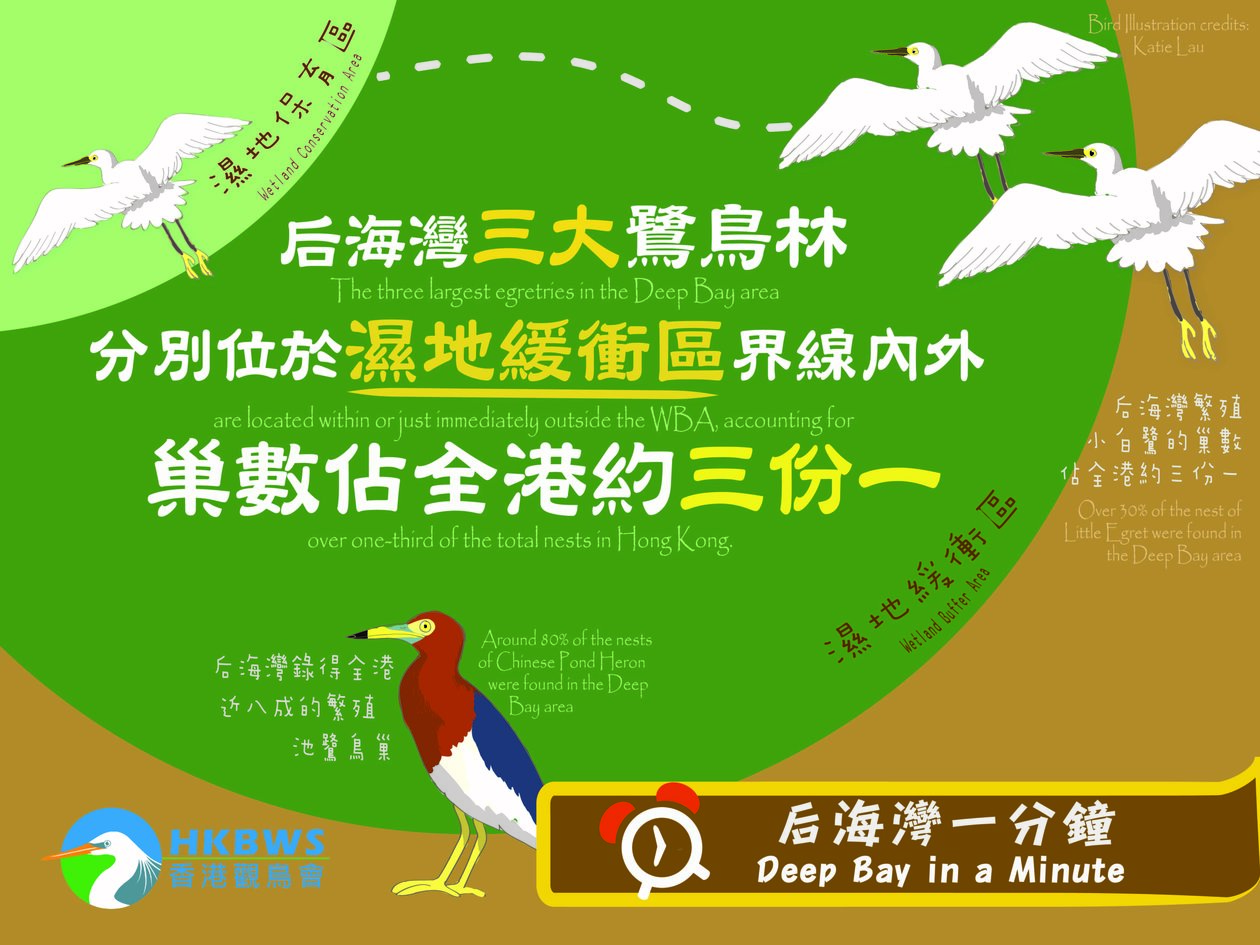
Herons and egrets nest together in colonies called egretries (which is also known as nesting colonies). In Hong Kong five species breed regularly in some 20 colonies, they are Little Egret, Great Egret, Eastern Cattle Egret, Black-crowned Night Heron, and Chinese Pond Heron. The restrictedness of the nesting sites of these species are of Local Concern, except for Little Egret and Great Egret which are of Regional Concern. Deep Bay wetlands is one of the important foraging grounds to these breeding egrets and herons.
In the “Study on the Ecological Value of Fishponds in the Deep Bay Area (1997)”, Tsim Bei Tsui egretry, Mai Po Village egretry and Ho Sheung Heung egretry were selected to study the flight paths of the breeding birds from the egretry and the corresponding landing location. Results showed the birds mainly fly to the inter-tidal mudflats, operating fishponds and drained fishponds, while they tend to avoid places used for open storage (commonly known as brownfields), residential areas and construction sites. Most birds flew less than 2km from their nests, but some can reach a distance as far as 4km due to the surrounding topography of the egretry. In order to safeguard these breeding egrets and herons, the nesting locations together with feeding grounds and flight paths of the birds should all be protected.
In 2018, the three largest egretries in the Deep Bay area were Mai Po Village egretry, Tung Shing Lane egretry and Mai Po Lung Village[1]. The sum of the nests in these three egretries accounts for over one-third of the total number of nests in Hong Kong. These nest locations are within the Wetland Buffer Area (WBA) or just immediately outside the WBA. Besides, WBA serves as a flight path/corridor such that the breeding egrets and herons can access their foraging grounds and wetlands in the Wetland Conservation Area (WCA). Therefore, WBA has its ecological function and role to play in the Deep Bay wetland ecosystem, and should be adequately protected from development threats.
Pond bunds: an ecological fabric or development tactic?
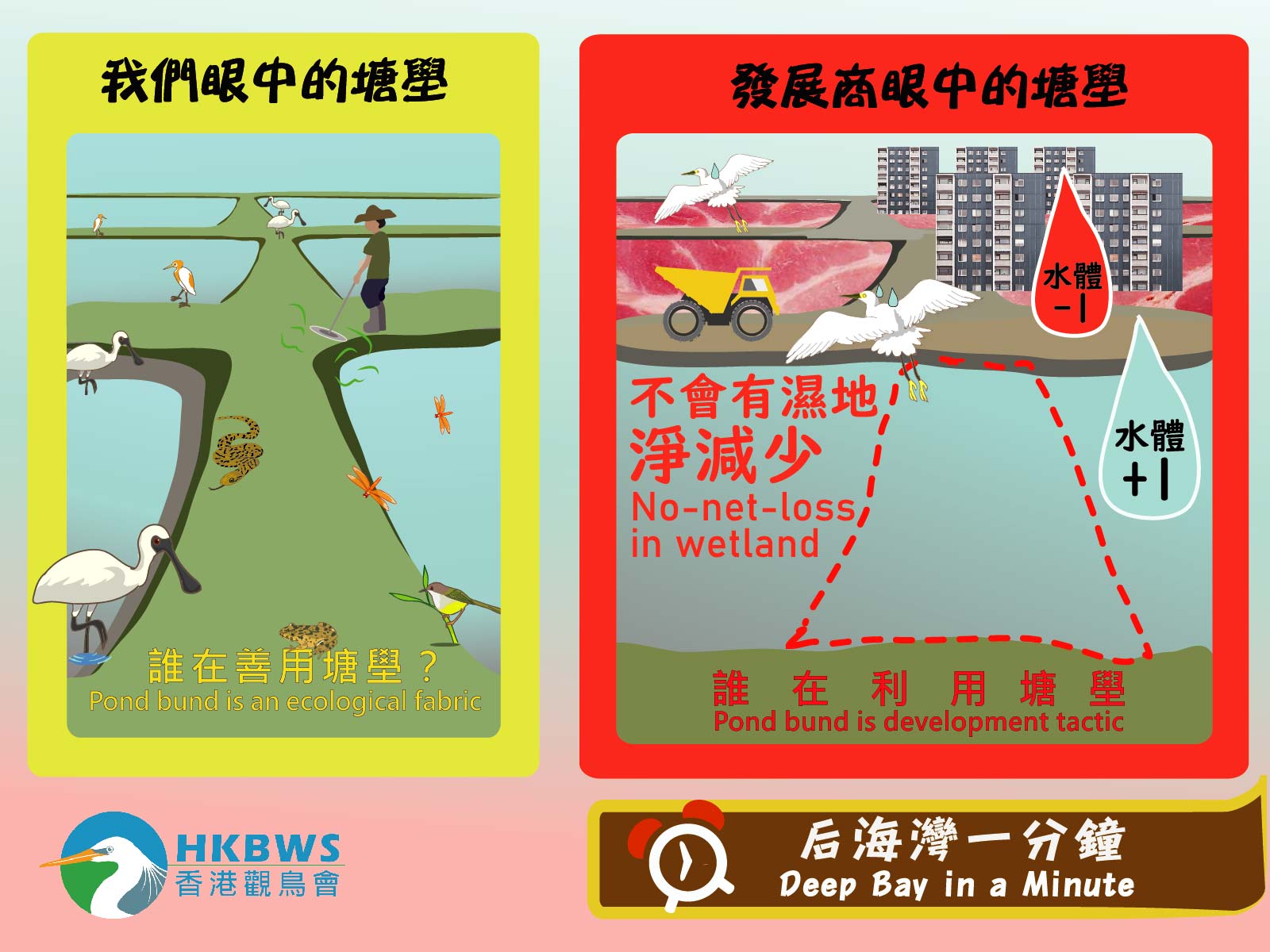
Pond bunds are an integral part of the fishpond operation and the Deep Bay wetland ecosystem. For example, fish farmers use the grass grown at the pond bunds to feed the Grass Carp in the fishponds. Besides, the vegetated bunds serve as a shelter for water birds and provide alternative food sources to insect- and seed- feeding birds such as warbler, buntings and pipits. A preliminary investigation was conducted for terrestrial invertebrates in four vegetation types on pond bunds under the “Study on the Ecological Value of Fishponds in the Deep Bay Area (1997)”. It was found that scrub has the highest taxa richness, reed held the greatest density of individuals, grass has the highest biomass, while bare ground held the lowest in count and biomass of invertebrates among them all. However, from our observation, un-vegetated fishpond bunds also provide roosting habitat for ardeids such as Little Egrets, Great Egrets, and Black-faced Spoonbills. Therefore, both vegetated and un-vegetated fishpond bunds have their own ecological functions in the Deep Bay wetland ecosystem.
In order to meet the Deep Bay planning principle of “no-net-loss in wetland”, developers have tried to remove pond bunds so as to increase the “wetland” area (i.e. water surface of fishponds) to compensate the wetland loss caused by the development. AFCD commented on the previous Nam Sang Wai development (planning application no. A/YL-NSW/218), saying that so-called “no-net-loss in wetland” claimed by the developer “only calculated the difference in area of ‘water surfaces’ before and after development without considering the extensive development area and its ecological impact…omission of the pond bunds in the calculation of the existing wetland area would underestimate the area of wetland loss.” Similar tactic was used in Fung Lok Wai wetland, leading to an environmental NGO to launch a judicial review against the Town Planning Board’s approval of the residential development in the locality. HKBWS considers that such “no-net-loss in wetland” calculation method is unacceptable and misleading.
Further Reading:
【TOWN PLANNING BOARD GUIDELINES FOR APPLICATION FOR DEVELOPMENTS WITHIN DEEP BAY AREA - UNDER SECTION 16 OF THE TOWN PLANNING ORDINANCE】
https://www.info.gov.hk/tpb/en/forms/Guidelines/pg12c_e.pdf
【Oppose the sacrifice of “Wetland Buffer Area” (WBA) for wetland conservation in Deep Bay】
https://cms.hkbws.org.hk/cms/en/hkbws/work/monitor/other-monitor/wba-en


